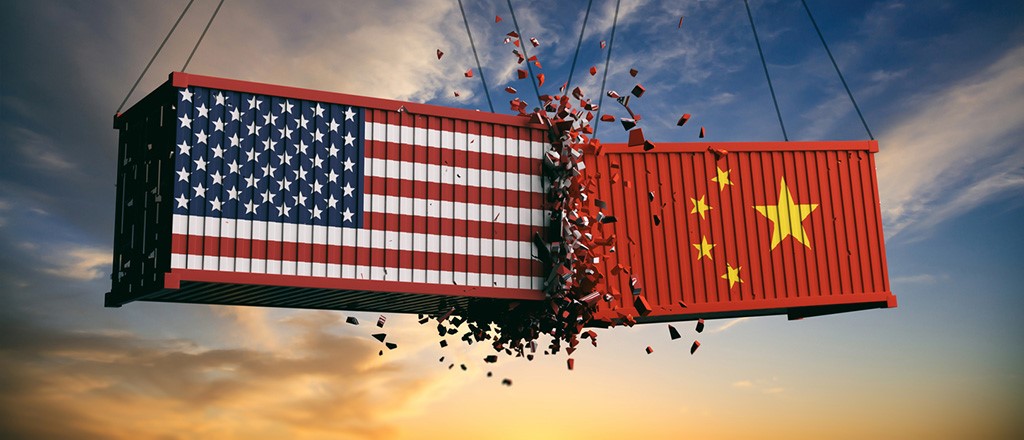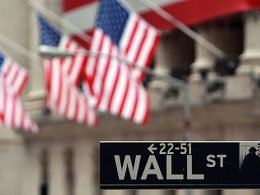The last year-and-a-half has seen a steady escalation of a trade war between the world’s two major capitalist powers, the United States and China. This dispute takes place against the background of the world economy undergoing a period of what has been described as “slowbalisation” and a reversal of the process of globalisation, writes Cillian Gillespie.
In May of this year, Donald Trump imposed a 25% tarriff rate on $200 billion worth of Chinese imports to the US. This brings to $250 billion the tariffs placed on such imports by the Trump regime since the dispute began in January 2018. The Chinese Communist Party (CCP) regime responded in kind by imposing tariffs on $60 billion worth of goods and services from the US. This represents a dramatic shift in world relations.
The period preceding the “Great Recession” of 2008 was characterised by growing and mutual dependence between China and the US. The US acted as the “buyer of last resort”, with cheap credit being provided to American consumers based on significant borrowing from Chinese savings, while China acted as the “workshop of the world” and underwent a boom in exports that helped fuel its economic growth.
Threat of new recession
This trade dispute is more than a temporary spat. We are witnessing the emergence of a new “Cold War” between these two states, albeit one fundamentally different from the Cold War that existed in the period following the Second World War up until the collapse of the Soviet Union. That was a clash between two rival economic and social systems, represented in the main by US capitalism and the Soviet Union. The latter consisted of an economic system based on a state-owned planned economy where capitalism had been abolished, but which was ruled by a privileged, dictatorial bureaucracy.
The conflict between the US and China is rooted in the rise of the latter as a growing capitalist power, and the relative decline of US capitalism. This conflict is economic and geo-political in nature, with the Chinese regime seeking to exercise its power and influence globally. Unlike Japan, which was previously the main competitor of the US, but one that was militarily subservient to it, China is not just an economic colossus, but also a formidable military power.
A sharp focus of this clash is the question of competition in the high-tech industries. The representatives of US capitalism, both Republicans and Democrats, are increasingly worried about competition from Chinese companies such as Huawei. Companies like Apple, Alphabet and Amazon constitute the most profitable section of the US economy, and they will jealously guard their global hegemony.
They are also concerned by Chinese capitalism’s development of technology such as 5G, the new mobile internet technology, which the Trump Presidency claims is a national security risk. The city of Shenzhen, in South-East China, is predicted to become the next Silicon Valley, furthering the challenge to the US’ long-term dominance of this sector.
Since 2015, the dictatorship of Xi Jinping has pursued a policy entitled “Made in China 2025” with the aim of becoming a “manufacturing superpower”, with Chinese capitalism, closely connected to the CCP regime, dominating aerospace technology, including aircraft engines and airborne equipment; and also dominating biopharmaceuticals and high-performance medical equipment. Chinese capitalism is transitioning from a labour-intensive economy to a capital-intensive economy, and wants to develop and export more technologically-developed, high-value goods. This is seen as fundamentally a threat to the profits and power of US capitalism.
This conflict is taking place in advance of a likely downturn in the world economy and, in fact, is a key contributing factor to such a development. The ballooning indebtedness of the major capitalist countries, with interest rates being slashed by the world’s central banks to near historic lows at near-zero rates, means that the system’s proverbial toolkit and ability to take measures to counter another recession has diminished significantly. Also, in 2008, the representatives of the capitalist class in the G20 largely co-ordinated their response to the crisis through stimulus measures and quantitative easing. Given the context in which the next downturn will take place, such cooperation is unlikely to be repeated.
Imperialist tensions and globalisation
The trade war is symptomatic of a malaise within capitalism globally, which has seen a growing tendency towards protectionism in the form of new tariffs and regulations over the last decade, and a growing rivalry between the major capitalist powers. The last ten years have produced the weakest economic recovery since the Second World War, evidenced by a decline in world trade and economic co-operation. This process of increasing capitalist rivalry and tension poses the question as to what degree we are witnessing a reversal of the process of globalisation that accelerated enormously in the period of the 1990s and the first decade of this century.
Globalisation can be understood as the process produced when the world economy sees the rate of global trade significantly outstrip the rate of economic growth. The period preceding 2008 did see such growth in trade, as well as significant liberalisation of international capital flows and the greater integration and interdependence of the world economy through the growth of ‘global supply’ or ‘global value’ chains, meaning production of goods such as mobile phones and cars is spread over a whole number of countries and continents — connecting rubber plantations in Malaysia with tire manufacturers in China, for example. Another noteworthy example of the emergence of such chains is the growth of the Taiwanese company Foxconn. It oversees one of the largest workforces globally, mainly concentrated in China where its workers live under brutal conditions, and acts as a supplier to major tech companies such as Apple.
De-globalisation
Since the “Great Recession” of 2008 there has been a significant reversal of the factors that spurred on globalisation in the period prior to this. Capital controls have been imposed in countries as diverse as China, Cyprus, Iceland and Brazil in order to prevent the destabilisation of their currencies. There has been a significant decrease in the amount of capital that has moved between countries in the form of stock or bond purchases or lending and foreign direct investment. In 2007, the figure stood at $11.9 trillion, but by 2015 it had fallen to $3.3 trillion.1 In 2018, investment by China in Europe and the US fell by 73% and the value of investment by multinationals globally fell by 20%.2
Having expanded on an annual basis by 4% in the preceding two decades, global supply chains stagnated from 2011 onwards. There are real limitations on the ability of capitalist companies to repatriate these supply chains, given the amount of investment they have poured into them, often spanning multiple states, something that has been highlighted by the Trump administration since it came to power in January 2017. In a sense, this illustrates that the degree to which globalisation itself can be reversed is highly constrained.
The period following the Great Recession has also seen a marked decline in the growth of world trade. Between 2011 and 2015, the global value of merchandise exports contracted by 10% and, in 2019, growth in global trade is expected to decline to 2.6%, generally mirroring the sluggish growth in the world economy itself. In the three decades prior to 2012, growth for world trade would have stood at 6%.
This is what capitalist commentators refer to as “slowbalisation”, as the decline in trade reflects the decline in demand for goods and primary commodities such as oil and gas. Trade has also been affected by a rise in tariffs and regulations. A World Bank report issued in November 2017 (before the opening salvos of the current US-China conflict) found that 7,000 such measures had been introduced in the last decade, half of which were aimed at China.4
Neo-liberal “political centre” undermined
Hand in hand with the globalisation of the world economy from the 1970s onwards was the implementation of neo-liberal policies on the part of the capitalist class and its representatives. As the post-war boom period gave way to economic crises and declining profit rates, the capitalist class — with Thatcher in Britain and Reagan in the US leading the charge — sought to increase the exploitation of the working class. This encouraged an intense race to the bottom in workers’ rights and conditions, stagnating wages, an assault on trade union rights, privatisation of public services and enormous cuts in social expenditure.
It saw an increasing shift away from investment in the productive manufacturing base of the economy and a massive rise in finance capital, with the emergence of speculative bubbles in shares, property etc. This in turn saw the destruction of the industrial base in advanced capitalist countries, such as those in Europe and North America. The major corporations increasingly outsourced production to the East and “Global South”, where they could maximise profits as a result of lower wages and woeful conditions.
Combined with the impact of the crisis of 2008, the implementation of these policies over decades has led to deterioration of support for the representatives of capitalism that articulated and advocated the virtues of globalisation and neo-liberalism. This so-called “political centre” was made up of both the traditional parties of the capitalist establishment and the former social-democratic parties in Europe, who embraced the logic of neo-liberal capitalism in the aftermath of the collapse of Stalinism. The Brexit referendum and the ensuing political crisis for the ruling class in Britain is a stark reflection of this trend.
It can also be seen with the emergence of right-wing populist forces, most notably Donald Trump, that have cynically railed against globalisation and its impact on working-class people. The other side of this process in the US has been the support for the Presidential candidacy of Bernie Sanders from 2015 onwards, the growing revival of the trade union movement and the increasing support for “socialism”, particularly amongst young people. This poses a political problem for the capitalist establishment, in the sense that there has clearly been a drastic undermining of the social basis and support for globalisation and neoliberalism, and a growing realisation that it has not delivered for working-class people.
On the contrary, in the advanced capitalist world, it has delivered an undermining of living standards. In the neo-colonial world, it has meant the destruction of the indigeneous manufacturing base that had been built up in the post-war period, as trade barriers became “liberalised” and open to competition from companies from the major imperialist states.
Capitalism: a global economic system
Since its birth, capitalism has been been an international economic system based upon the emergence of world trade and an international division of labour. The modern process of globalisation and integration of the world economy was undoubtedly fueled by the development of new technologies such as those in communication, which facilitated a greater development of trade and an increased ability of capital to move across borders. However, it ultimately reflected a trend inherent in capitalism: the desire of capitalists to find new markets and new arenas to invest their excess profits in. This internationalised nature of capitalism was something analysed by Karl Marx and Friedrich Engels in the Communist Manifesto in 1848:
“The bourgeoisie has through its exploitation of the world market given a cosmopolitan character to production and consumption in every country… All old-established national industries have been destroyed or are daily being destroyed. They are destroyed by new industries whose introduction becomes a life and death question for all civilised countries, by industries that work up raw materials drawn from the remotest zones, industries whose products are consumed in every quarter of the globe… The bourgeoisie, by the rapid improvement of all instruments of production, by the immensely facilitated means of communication, draws all, even the most barbarous, nations into civilisation.”
However, Marx and Engels also understood that capitalism was a system based on the nation-state, in which different national states exist ultimately to defend the interests of their own indigeneous capitalist class, through measures such as tariffs against foreign capital, currency manipulation to make their exports more competitive and, in more extreme cases, wars. Capitalism is a system based on the creation of a world market and, at the same time, based on competition between rival nation-states; this is a fundamental contradiction at its heart. The degree to which the world economy has become integrated over the last number of decades means that, with the emerging global trade war today, this contradiction has never been greater.
1870-1914- First phase of globalisation
Although historical analogies are always conditional, it is useful to look back at a previous period of “globalisation” which gave way to a period of protectionism and sharp conflict between various capitalist powers. The period from 1870 to 1914 is regarded as the first real example of globalisation of the world economy. This saw rapid growth in world trade, an increase in migration and in the free movement of capital. The world economy became increasingly dominated by the major imperialist powers engaging in colonisation of large chunks of Africa and Asia in order to exploit their natural resources and markets.
This era of imperialism, or what Lenin called “monopoly capitalism”, gave the lie to the idea that capitalism could ever be based on “free trade”, in contradistinction to protectionism. The economic development of the economies of the colonial world remained stunted as a result of imperialist exploitation, unable to develop an indigeneous manufacturing base. The imperialists sought to plunder the resources of the colonial world and ensure that they did not emerge as competitors. In 1830, these countries accounted for 50% of world manufacturing. By 1913, however, this figure had fallen to 7.5%.5
The increasing integration of the world economy on the eve of the First World War was graphically illustrated by the economist John Maynard Keynes, who wrote:
“The inhabitant of London could order by telephone, sipping his morning tea in bed, the various products of the whole earth… he could at the same moment and by the same means adventure his wealth in the natural resources and new enterprises of any quarter of the world.”6
Yet this period was also to witness heightened competition between the major imperialist powers themselves, as – much like today, with the US and its rivalry with China -the status of British capitalism became increasingly undermined by its rivals, namely Germany and, to a lesser extent, the US. This resulted in growing militarisation and ultimately gave way to the outbreak of the First World War in August 1914. This was something that many of the leaders of the Second or Socialist International were unfortunately blind to, seeing this period of capitalist development as one of stability as the system internationally became more interdependent and would not therefore bring about further wars or revolutionary upheaval. Karl Kautsky, the most prominent and authoritative of its theoreticians, argued in September 1914 that notwithstanding the outbreak of the war:
“…the capitalist economy is seriously threatened precisely by the contradictions between its States. Every far-sighted capitalist today must call on his fellows: capitalists of all countries, unite!”7
His argument reasoned that the era of imperialism reflected simply a policy of the capitalist class rather than a unique period of its development, and would give way to a period of “ultra-imperialism”, where tensions between the imperialist states would be mitigated by an understanding that their system was in peril:
“The longer the War lasts, the more it exhausts all the participants and makes them recoil from an early repetition of armed conflict, the nearer we come to this last solution, however unlikely it may seem at the moment.”8
Capitalism and the nation state
Not only did this barbaric slaughter drag on for another four years, until revolution from below forced its conclusion; it set in train a period of stagnation and protectionism from 1914 until 1945. The capitalist class increasingly adopted a “beggar thy neighbour” policy of protectionism, with the implementation of new tariffs and the devaluation of currencies to make their exports more competitive. This was particularly the case in the aftermath of the Wall Street Crash in 1929, which led to the Great Depression. Ultimately, the unresolved tensions between the major imperialist powers culminated in the outbreak of a new world war in September 1939.
During the heyday of globalisation in the 1990s, capitalist commentators argued that their system had entered a new paradigm and had, in fact, overcome the limitations of the nation state. This argument was put forward in the context of their system being ideologically strengthened following the collapse of the Stalinist regimes in the Soviet Union and Eastern Europe, and the rightward shift of the former parties of the working class.
The argument was even echoed by some of the left, including those with considerable ideological influence within the emerging anti-globalisation movement of the late 1990s and early 2000s, such as Michael Hardt and Antonio Negri. In their book Empire, they argued:
“that sovereignty has taken a new form, composed of a series of national and supranational organisms united under a single logic of rule. This new global form of sovereignty is what we call Empire.”9
In reality, the ‘supranational’ institutions of global capitalism such as the World Bank and the International Monetary Fund, which developed in the post-war period, were not separate from the existence of capitalist nation states. They remained under the hegemony of US imperialism, which was by far the most dominant capitalist power after 1945. This economic and military hegemony is now being challenged by a rising China. While companies like Apple and Google are multinational in character, their homebase is the US. This is also true of the emerging Chinese companies that are now competing on the world market.
Capitalism today is based on crises and stagnation. This is giving way to greater instability, clashes and inter-imperialist rivalry. The US-China rivalry is unlikely to take the form of all-out military conflict in the medium term, given that his could lead to nuclear annihilation and more broadly is something capitalism will seek to avoid. However, this system will prove itself incapable of resolving any of the fundamental problems confronting humanity, not least the destruction of our ecosystem. This requires cooperation between states and democratic planning for the needs of people and our planet, not the competition and the ruthless drive for profit that the system is built on.
Capitalism as a world system has created a force that shows a way out of the crises facing our future — the international working class, which today is larger and potentially more powerful than ever, and is linked by a common interest in fighting for a democratic socialist world, based on the common ownership of its wealth and resources. On this basis, we can tear down the borders that capitalism has built up and construct a society based on real equality and the fulfilment of our needs.
Notes
1 “Globalisation In Retreat: Whatever Happened To Free Trade”, Wall Street Journal (29 March 2017)
2 “Is the world economy still slowbalising”, The Economist (online edition, 17 April 2019)
3 ‘Global trade growth loses momentum as trade tensions persist’, www.wto.org (2 April 2019)
4 “Globalisation In Retreat: Whatever Happened To Free Trade”, Wall Street Journal (29 March 2017)
5 Martin Upchurch, “Is Globalisation Finished”, http://isj.org.uk/is-
6 Quoted in, Larry Elliott, ‘Globalisation once made the world go around. Is it about to grind to a halt?’, The Guardian (21 January 2017)
7 Karl Kautsky, “Ultra Imperialism”, (September 1914), www.marxists.org
8 Ibid
9 Michael Hardt & Antonio Negri, Empire, Harvard University Press (2001), Introduction, pvii












